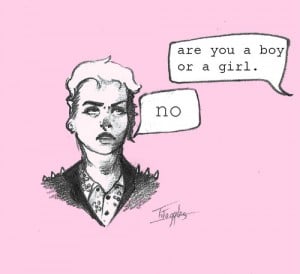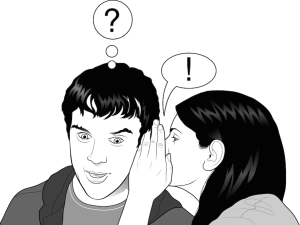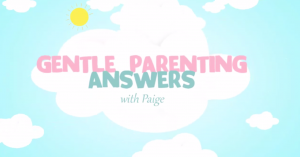As Donald Trump begins a presidency that will be historic for all the wrong reasons, many feminist and marginalized folks are wondering how we’re going to resist him without burning ourselves out.
It’s a question that some ask quietly or obliquely or not at all, feeling ashamed for even thinking about such things when there is so much to be done: Shouldn’t we put the greater good first, and our own needs second?
I think that it’s actually because there is so much to be done that we need to be asking this question louder and should feel free to ask it without shame.
There is so much to be done, and if you want to resist, it makes sense to think about how you’re going to do that without depleting yourself.
It’s no different than bringing along food and water on a long and difficult hike.
These seven questions can help you get a better sense of your interests, priorities, needs, and potential challenges – as well as what needs to be done – when it comes to activism.
You can even take this quiz to get an idea of what your activist superpower is and how you might best contribute to the resistance!
They may not guarantee a perfect balance between your needs and those of others, but they’ll help you move toward that.
If journaling or list-making is something you find helpful, you might want to try writing down your answers to these questions. That’ll also make it easier to reflect on your answers later, and to see if you need to change your approach.
Whether or not you write anything down, though, simply reflecting can help you choose a course of action and find a balance between resisting Trump and caring for yourself.
1. What Needs to Be Done?
This one might be easy to answer. Most of us are constantly being bombarded with news articles, opinion pieces, tweets, Facebook posts, and petitions that demand us to act.
While it might be tempting for some to try to separate the “actually” important things from the things that can wait, honestly, I haven’t seen a single call to action that hasn’t seemed very important to me.
That’s the whole problem. It all matters. We can’t possibly accomplish all of it, not even if we work together.
However, making a list of what needs to be done is still a good place to start, because it’ll help make the next questions easier to answer.
If you’re not sure where to start, there are a lot of useful resources for people hoping to resist Trump and his agenda.
You can also try making a list of broad topics for activism – for example, police brutality, trans rights, immigration, anti-Muslim legislation, voting rights – to help you choose which ones to focus on in your own resistance efforts.
As always, remember to listen for the most marginalized voices.
If you don’t specifically listen for them, you’ll fall for the trap of only listening to mainstream conversations, where marginalized voices are drowned out by more privileged ones.
Listening to marginalized voices is how I learned that there is already a precedent for a Muslim registry, and why telling everyone (specifically, women of color) to get IUDs can be harmful. It’s also how I discovered this fantastic poem about resistance, which I now think about whenever I feel overwhelmed with all this.
There is so, so much that needs to be done.
These next two questions will help you narrow it down to something that makes sense for you to do.
2. What Am I Best At?
One way to get started with activism is to choose something that you’re already good at, or that fits with other skills you have.
For instance, I love writing, cooking, and organizing social events. So, along with a friend, I started hosting monthly parties for my friends to get together and write letters to our elected officials. We provide food, tea, stationery, stamps, and ideas, and together, we write dozens of letters in a few hours.
Starting with things I’m already good at has helped me feel confident and optimistic about my ability to resist this new political world.
Later, I will almost certainly branch out, try new things, and probably fail a little bit. But I know I’ll be able to handle that because I know I’m making a difference already.
3. What Am I Passionate About?
Maybe your answer to this is the same as your answer to the previous question. (For me, it is – at least for now.) But sometimes you might feel passionate about trying something new and developing a different set of skills – or the things you’re good at just don’t seem to apply.
Although, just about anything can be a form of resistance.
Are you a computer programmer? Volunteer to teach kids from marginalized communities how to code. A musician? Rally a group of performers, and host a benefit for a cause you care about – a bunch of performers in my city recently got together to host a Standing Rock benefit show.
Thinking about what excites and inspires you can be a good way to start figuring out a plan of action for your resistance.
Things like passion can seem irrelevant in times like these. After all, shouldn’t we all be doing what is needed most, rather than what we happen to like personally?
I do think we should educate ourselves about what’s actually needed – which is why that was my first step.
But I also think activism needs to come from more than just a place of duty and obligation, especially when we have so much to do over a long period of time.
This is a marathon, not a sprint. Doing things you’re passionate about (or things you’re good at) helps you keep running longer and can help prevent burnout.
Of course, burnout and traumatization can happen even if you’re doing something you love and something that matters. That’s what the rest of these questions are for.
4. What Are My Boundaries?
Boundaries aren’t just for sex and relationships.
We have boundaries around all types of things – which foods we’ll eat, which places we’ll go to, which activities we’ll engage in, which types of interactions we’ll have with others, including strangers.
Boundaries are important in activism, too. Not everything that needs to be done is something that you’re able and willing to do.
I’ll talk more about some of these restrictions in the next section, but for many reasons, it’s okay to decide that certain types of activism – or certain issues – are not ones that you’re able to engage in.
Through your activism, you’ll probably interact with other activists in various spaces and communities. Some of these spaces and communities may replicate systems of oppression such as racism, trans antagonism, or ableism.
That’s another reason boundaries are important.
While we’ll all probably end up working with people we don’t fully agree with or don’t necessarily like, there are some behaviors we can’t accept from others. Unfortunately, some communities are abusive, and progressive ones are no exception.
Just because a person or movement is working for causes that are important to you doesn’t mean that you’ll feel safe in those spaces, and it doesn’t mean that you have to force yourself to remain there.
You always deserve to be treated with dignity and to have your boundaries respected. The fact that this work is very important and these causes are very urgent doesn’t excuse people from that basic responsibility.
For instance, my boundary is that I will not work with people who invalidate my feelings or shame me for personal choices that don’t harm others.
I will not participate in activist communities that ridicule people for their appearance or their (consensual) sexual choices, even if they’re doing it to someone other than me. It doesn’t matter how progressive they are otherwise.
It isn’t always clear what a personal boundary is and what a harmful action is, though.
In order to tell the difference, we have to be open to feedback and critique from others, especially marginalized folks who don’t share the same privileges we have.
For instance, if I decide to shave my head because that’s what I want to do, it’s inappropriate to shame me for that just because it’s not what you’re used to.
If I decide to wear my hair in locs, though, that’s no longer just a personal choice about my appearance. That’s an action that harms Black folks by appropriating their resistance against white supremacy for the sake of a fashion statement.
Before you decide that your personal choices don’t harm others, you have to make sure folks aren’t actually trying to tell you that you’re harming them.
That’s why setting appropriate boundaries in a social justice context requires listening to yourself and listening to others.
Identifying your boundaries in advance can make it easier to set them when the time comes.
After all, it’s easier to notice a boundary being crossed if you know what it is. With that said, you may recognize new boundaries as you move through different spaces and take on new roles. So, this is a list that you might update over time.
5. What Challenges Am I Facing?
If you’re reading this, there’s a good chance you’ve done a lot of processing about this already. But as we move into the self-care portion of this process, it’s a good idea to intentionally reflect on it again.
A challenge is anything you think will make it harder for you to engage in the activism that you want to do.
Challenges can be personal and situational – maybe you have anxiety about making phone calls, or your work schedule doesn’t allow you to attend protests.
Challenges can also be institutional. If you lack a certain type of privilege, that probably impacts your ability to engage in activism.
For instance, if you’re an undocumented immigrant, protests can be dangerous in a way that they aren’t for US citizens. Disabled people may find many activist movements inaccessible.
If your physical or emotional safety requires you to be closeted about certain things, you may not be able to out yourself as a form of activism.
Sometimes you might try to overcome a challenge. For example, I know a lot of people who have been working on their phone anxiety and making themselves call their senators and representatives.
It’s still important to recognize that this is hard for you, though – to hold space for that and to acknowledge that changing yourself is a process and won’t happen overnight.
6. How Will I Know When I Need to Move Back?
Thinking about red flags for burnout or trauma before they happen can help you notice if and when it starts to happen – otherwise, we often miss these warning signs until things have gotten pretty bad.
First of all, it can help to familiarize yourself with what burnout looks and feels like. It’s not always the same for everyone, so try to think back to previous times you’ve been overwhelmed with what you were doing and what that was like.
Sometimes burnout looks like not caring anymore. Sometimes it’s being convinced that positive change isn’t even possible. Some of us were already in that space right after the election – I certainly was.
That’s how I knew that I needed to spend the months leading up to the inauguration to care for myself and prepare myself for resistance, rather than trying to force myself to jump into it right away.
Burnout isn’t necessarily the only thing to watch out for.
For many of us, resistance work is triggering and (re)traumatizing. As we continue to move forward and resist post-election, we may not be able to avoid more triggers and trauma.
But, as I said before, you get to decide what your boundaries are. You get to decide how much is too much.
Yes, the resistance needs you, but more importantly, you need you. You are not required to set yourself on fire to keep others warm.
7. What Will I Do to Care For Myself?
What will you do when it’s all too much? Even more importantly, what will you do regularly – no, daily – to try to keep it from becoming too much?
(Even then, it may become too much. This is not your fault. This whole situation is too much.)
When things are too much for me, I disengage from the bigger picture for a while, and focus on being a source of love and support for my friends, family, and partners. Caring for others in a tangible way helps me replenish myself.
Every meal I cook, every smile I bring to someone’s face, every small gift I give helps me feel like the things I do matter and have an impact on the world, even if it’s just a little corner of it. Eventually, I’m able to bring that perspective back to my activism.
Caring for others as a form of self-care might sound odd, and it’s definitely not for everyone.
Other people I know have cared for themselves by temporarily disengaging from political news, or choosing specific times of day to engage with it rather than glancing at it constantly. Others have increased their amount of physical activity (this is something that helps me a lot, too).
Some reach out to others for support, and find someone who is able to do that emotional labor and hold space for them.
Although we’re all struggling to find “the right thing to say” to help loved ones who are feeling hopeless and overwhelmed by what’s going on, sometimes there is no right thing to say. Sometimes there’s just listening and saying, “I know. It really sucks.”
Whatever you need to do for yourself is okay as long as it honors others’ boundaries and doesn’t harm anyone.
It may take you a while to discover what it is.
Learning how to care for yourself is a lifelong process, and I don’t think any of us know everything there is to know about it yet.
***
When you’re having a hard time with balancing self-care and resistance, pull out your answers to these questions, and reflect on them.
You might find that you need to change some of your answers because you may have answered them in a way that makes balance impossible. Maybe it is impossible, but I think we can always look for more of it, even if we’ll never get all we need of it.
Remember: This will be a marathon, not a sprint. That might feel dauntingly long, but it also means you have a lot of time to find your stride.
[do_widget id=’text-101′]
Miri Mogilevsky is a Contributing Writer for Everyday Feminism. She is a recent graduate of a Masters in Social Work and is starting a career as a counselor in Columbus, Ohio. She loves reading, writing, and learning about psychology, social justice, and sexuality, and is working on her cat photography skills. Miri writes a blog called Brute Reason, rants on Tumblr, and occasionally even tweets @sondosia. Check out her articles here.
Search our 3000+ articles!
Read our articles about:
Our online racial justice training
Used by hundreds of universities, non-profits, and businesses.
Click to learn more





















